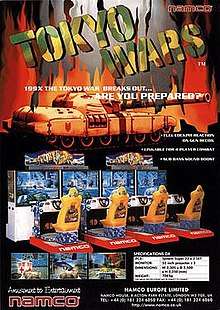Tokyo Wars
Tokyo Wars (トーキョーウォーズ, Tokyo Wōzu, "Tokyo Wars")[5] is a 1996 first-person action video game developed and published by Namco for the arcade. The storyline provided by the game's promotional poster states that the game takes place in the 1990s.
| Tokyo Wars | |
|---|---|
 European arcade flyer | |
| Developer(s) | Namco[1] |
| Publisher(s) | Namco[2] |
| Composer(s) | Akihiko Ishikawa[3] |
| Platform(s) | Arcade |
| Release | |
| Genre(s) | Action[2] Simulator[1] |
| Mode(s) | Single-player[1] Multiplayer (from 2 to 8 players in multiplayer mode[1]) |
| Cabinet | Sit-down[4] |
| Arcade system | Namco System 22 |
| Sound | Namco C352 |
| Display | Raster horizontal[5] |
Gameplay

This game allows one to eight players to control separate tanks (either as teammates or as opponents).[6] The player(s) can play either in the heart of downtown Tokyo or at the city's bayside dock.[6] However, the players have twenty seconds to make all the decisions before the game automatically locks them in.
The deluxe cabinets features a pneumatic haptic control that simulates the recoil effect from the tank's main gun.[5][6] Since the regular cabinets do not offer an air-powered recoil, the deluxe edition delivers slightly more realism than the normal cabinet.[6] Arrows on top the screen help determine teammate from opponent because twenty tanks are rushing down the battlefield looking for an easy kill. While cars can always be demolished by crushing them over, some of the passageways in the game would crumble under the weight of the massive tanks.[7]
A game lasts for fifteen minutes or until all opposing tanks are shot down. The game uses Namco's Super System 22 board,[5][8] with a custom cabinet. Players must sit down in order to play the game. Games can be played either as a competition with human players on both sides or cooperatively on the same team against AI-controlled opponents. Unlike most arcade games, high scores are not recorded and initials are not used to discriminate between the first player and the second player. The player has to look in his or her monitor to find out whether he or she has vanquished the opposition (which consists of twenty tanks[6]). Although only two players can play at a time, up to four machines can be interconnected to provide up to eight players a chance to compete in tournament-style matches.[9]
Types of tanks
The tanks represented in Tokyo wars have no real-life counterparts, as they are clearly derived from several different modern day tanks, amalgamated into original designs.
Reception
In Japan, Game Machine listed Tokyo Wars on their January 1, 1997 issue as being the most-successful dedicated arcade game of the year.[10] A reviewer for Next Generation said the game "is essentially a mondo, testosterone cannonfest with semi-fast tanks (faster than real tanks, but not as fast as you want them to be)", praising the large arenas with strategically useful cover and destructible scenery. He noted that the game was geared heavily towards two-on-two play, to the point where the cabinet is only sold in a four-player configuration, though single-player play is possible. He scored it four out of five stars.[11]
References
- "Developer information". Killer List of Videogames. Retrieved 2008-10-18.
- "Release information". GameFAQs. Retrieved 2013-07-23.
- "Soundtrack information". Video Game Music Database. Retrieved 2012-12-16.
- "Type of cabinet". allgame. Retrieved 2011-12-15.
- "Advanced information". Coinop.org. Retrieved 2008-10-18.
- "Misc. information". Everything2. Retrieved 2010-09-27.
- "Best Arcade Game You Can't Play at Home - Tokyo Wars". Giant Bomb. Retrieved 2012-12-30.
- "Model 3: Sega Affirms Arcade Supremacy". Next Generation. No. 17. Imagine Media. May 1996. p. 16.
- "Gameplay information". Everything2. Retrieved 2008-10-18.
- "Game Machine's Best Hit Games 25 - 完成品夕イプのTVゲーム機 (Dedicated Videos)". Game Machine (in Japanese). No. 533. Amusement Press, Inc. 1 January 1997. p. 33.
- "Tank Heavens". Next Generation. No. 19. Imagine Media. July 1996. p. 90.